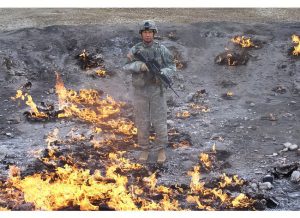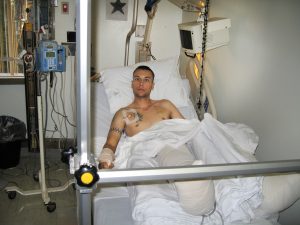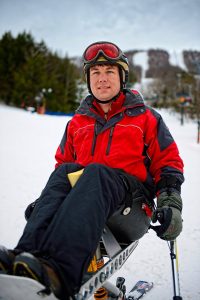Bryan Gansner, who barely survived war, helps other vets survive its aftermath
Only days after September 11, 2001, country star Alan Jackson wrote “Where Were You When the World Stopped Turning?” He would perform the song live to a teary-eyed audience at the CMA Awards two months later.
That heartfelt lyric comes to mind during a conversation with Bryan Gansner, a Knoxville U.S. Army veteran, chiefly because for him, 9/11 would lead to another day—July 6, 2006—when his world almost stopped turning. Gansner, 46, refers to it as “the day I got blown up,” when a bomb blast shattered both heels, shredded his right leg, caused an anoxic brain injury from loss of blood, and broke his wrist.
Many of the details of the incident were told to Gansner later. He didn’t recall the moment an improvised explosive device (IED) exploded under his Humvee, halting the convoy in which he was riding along a remote highway during Operation Iraqi Freedom.
And while he has no trouble recounting what he calls “my boo-boos” from that harrowing night, he adds, “I prefer to talk about all the life since then,” and especially his hottest pursuit: helping fellow veterans to recover from PTSD and other conditions that often lead to taking their own lives. “The boo-boos are what led me here, and my mission is to help prevent suicide,” Gansner says.
A Midnight Ride
What he also calls “the accident” happened during Gansner’s second tour of duty in Iraq. He had been deployed from Ft. Campbell, Kentucky, in 2003-04, and then returned to Iraq in September 2005, ten months before the IED attack.

That night, Gansner’s squad was on a routine scouting operation, taking Route Cherry, north of Kirkuk, when they passed through a train trestle. Around that moment, a radio call urged the convoy to take caution because “we caught a guy up the road placing an IED.”
“Thanks,” replied Gansner, whose vehicle also carried the driver, a gunner, and an interpreter.
Suddenly, it seemed, Gansner was thinking, Where are my Oakleys [glasses]? “Everything was black, stuff was in my eyes, the air was thick. The driver asked if I was OK. I said, ‘I think I’m hurt.’ That’s all I remember saying.”
An IED had been tripped and exploded under the Humvee near Gansner’s seat. “There was so much smoke, I couldn’t see s***. I reached up to unlock the combat lock, but I felt uncoordinated. My arm was hanging down, blood was running out.”
The vehicle’s driver, SPC Richard Lucht, asked Gansner iif he was okay. “Yes, but I think I’m hurt,” he answered. The interpreter opened the door and fellow soldiers tried to pull Gansner out. His weapon had hit him in the mouth and lodged between his thigh and the roof of the Humvee. They cut the seatbelt and extracted him. “I don’t remember that part,” he says now.
So forceful was the explosion that an mp3 player that had been hanging near Gansner’s seat was later found 100 yards away, having blown out of the gunner’s hatch.
Gansner was in bad shape, but he was awake enough to remember a feeling: pride. “What makes me proud is that as I was lying there, everybody was doing what they had been trained to do, they were working on me and I just watched. I saw the work we had put into training these guys in action.”
Word traveled fast about the incident. One soldier was heard on a radio saying, “Oh my God, it’s Sergeant G!”—the nickname the troops called Staff Sgt. Gansner.
“I found out later that when we got back to the base at 2 or 3 in the morning, dozens of people were lined up to give blood,” he says. “The docs couldn’t locate the source of bleeding, so they were going through blood. They finally got it stopped enough to save my leg. It was humbling to hear that these guys I served alongside had such genuine concern. It might sound kind of odd, but it’s the proudest day of my life.”
Gansner’s first clear recollection is of waking up in Germany, several days after the explosion, with “a rack over my chest and tubes going everywhere.” He had been in a medically induced coma, couldn’t talk, and he was coughing up black sludge. His next memory is of being on a transport plane, “rows of gurneys on one side, medical equipment and personnel on the other,” then on a bus from Andrews Air Force Base to Walter Reed Army Medical Center. Within a day or so, his then-wife was there; he credits her with going above and beyond to care for him as his long, arduous recovery began.

Some of his buddies from Iraq also would visit, along with his parents. Gansner was at Walter Reed from early August to late September 2006, and then received outpatient care and physical therapy until March of 2008. He was honorably discharged from the Army on March 28, 2008.
As he lay in Walter Reed and then endured a painful rehab to try to repair his leg and heels, and learn to walk again, Gansner had time to reflect on his service and the path that had led him there.
Midwestern Roots
Bryan Robert Gansner, born November 29, 1977, in the farm town of Festus, Missouri, was a spirited young man who came of age “running through the woods and creeks and riding four-wheelers with my cousins.”
He recalls two indelible aspects of his childhood: one, he never met his father, and two, when he was 16 he learned that he had been adopted by his aunt and uncle. “I also found out depression runs in the family, which later on fed right into my PTSD, because I’m prone to that as well.”
He didn’t have much interest in the military—even though several family members had served in various branches—but during his junior year of high school, “the recruiters finally got to me,” and the appeal of serving led him to enlist in the Army. Soon after graduation, on July 11, 1996, he shipped out to Ft. Jackson, South Carolina, for basic training. His training as an artilleryman would lead him to Ft. Sill, Oklahoma, where he was stationed before later serving out of Baumholder, Germany.
Gansner’s primary role was “fire direction control, the brains of the artillery world. We would compute the data, chart where to target, move the gun this way.” He was part of a complex process leading to the point where “the gun bunnies, the muscle, would crank the knobs and place rounds in the cannon. If we had six guns, a typical battery, they were 50 to 200 yards apart, all hitting targets 7,000 meters away, each from a different angle, based on range to target, how much powder to use, up to 18 guns, hitting targets within 5 or 10 meters.”
Gansner rose through the ranks steadily. He served as a non-commissioned officer (NCO) for 10 of his 12 years in the military. His early roles included supervising radar operations, tracing incoming mortar fire, and dispatching responses accordingly. He was promoted to corporal and later to E5 and E6 (Staff Sergeant).
By 2000, he was stationed at Ft. Campbell, from which he was deployed several times, leading to his tours in Iraq and the explosion in 2006.

The Mountains Are Calling
In the years since he left the Army in 2008, Gansner has become dedicated to three major focus areas:
- One, helping fellow veterans navigate post-war trauma and discover hope and purpose;
- Two, hiking as many trails in the Great Smoky Mountains as possible; and
- Three, spending time with his two daughters—his eyes light up when he talks about them.
And no, that second item is not a typo. It says hiking. In what is a marvel even to himself at times, Gansner went from using a walker to slowly maneuver from his bed to the bathroom, to traversing 20.7 miles in one day on a hike to Mt. Camerer, the 10-mile round trip up the Alum Cave Bluffs route to Mt. Leconte, and hundreds of other miles in the Smokies and beyond.
Like other veterans we’ve met, Gansner credits getting out in nature and basking in the majestic beauty of the mountains with fostering a sense of much-needed peace. The meandering streams and rushing waterfalls he passes by have a way of quieting some of the echoes of artillery, enemy engagements, and exploding Humvees.
One source of inspiration were his buddies, especially Jon Atkins, whose death by suicide served to spur and motivate Gansner in his efforts to bring hope to fellow vets facing post-war challenges, and Ty J. Johnson, who was killed April 4, 2006, in an IED attack. Both men’s names are tattooed on Gansner’s arm as a living tribute and reminder. Gansner set a goal of watching the sunrise from atop Leconte by the fifteenth anniversary of Ty’s death in memory of his friend. Thanks to a tough training regimen, he achieved the feat a month early, in March 2021.
Looking back on his first few post-war years, Gansner says, “I tried to close the file drawer on my military life and move on. Later I learned you shouldn’t close it off completely. You can’t dwell on it, but you need to be somewhat involved in the veteran community. You need that connection. Trying to survive solo does you no good. I went through a lot of depression, and having people to hang out with made a huge difference.”
That’s partly why Gansner is so engaged with efforts to prevent veteran suicide. As he recounts stories of lives saved, and others who could not be saved, his eyes well with tears. The emotion is raw. His message to others is clear:
“Be on the lookout for vets and other people who need help, and jump on it. If I see any hint that a soldier is struggling—like if they ‘joke’ on social media about wanting to ‘take a dirt nap’—I will call them. If I can, I’ll meet them in person, put an arm around them, tell them they matter. They can find hope. That they’re not alone.”
In other words: don’t let the world stop turning. It’s a life-saving message Gansner has more than earned the right to convey.
If you’re a struggling U.S. service member or veteran, or a concerned friend, Irreverent Warriors and Stop Soldier Suicide offer a 24/7, confidential, trauma-informed service at (844) 689-0445. Don’t wait; reach out now to get connected to care and support.
